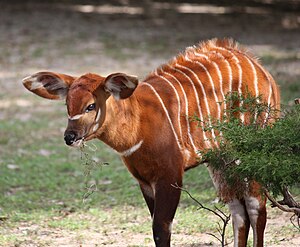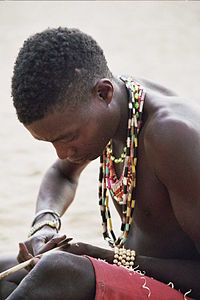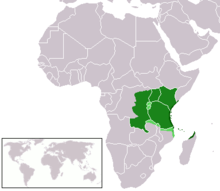Portal:Tanzania
 The Tanzania Portal
Tanzania, officially the United Republic of Tanzania, is a country in East Africa within the African Great Lakes region. It is bordered by Uganda to the northwest; Kenya to the northeast; the Indian Ocean to the east; Mozambique and Malawi to the south; Zambia to the southwest; and Rwanda, Burundi, and the Democratic Republic of the Congo to the west. Mount Kilimanjaro, Africa's highest mountain, is in northeastern Tanzania. According to the 2022 national census, Tanzania has a population of nearly 62 million, making it the most populous country located entirely south of the equator. Many important hominid fossils have been found in Tanzania, such as 6-million-year-old Pliocene hominid fossils. In the Stone and Bronze Age, prehistoric migrations into Tanzania included Southern Cushitic speakers who moved south from present-day Ethiopia; Eastern Cushitic people who moved into Tanzania from north of Lake Turkana about 2,000 and 4,000 years ago; and the Southern Nilotes, including the Datoog, who originated from the present-day South Sudan–Ethiopia border region between 2,900 and 2,400 years ago. These movements took place at about the same time as the settlement of the Mashariki Bantu from West Africa in the Lake Victoria and Lake Tanganyika areas. In the late 19th century, the mainland came under German rule as German East Africa, and this was followed by British rule after World War I when it was governed as Tanganyika, with the Zanzibar Archipelago remaining a separate colonial jurisdiction. Following their respective independence in 1961 and 1963, the two entities merged in 1964 to form the United Republic of Tanzania. Tanganyika joined the British Commonwealth and Tanzania remains a member of the Commonwealth as a unified republic. Tanzania is mountainous and densely forested in the north-east, where Mount Kilimanjaro, the highest mountain in Africa and the highest single free-standing mountain above sea level in the world, is located. Three of Africa's Great Lakes are partly within Tanzania. To the north and west lie Lake Victoria, Africa's largest lake, and Lake Tanganyika, the continent's deepest lake, known for its unique species of fish. To the south lies Lake Malawi. The eastern shore is hot and humid, with the Zanzibar Archipelago just offshore. The Menai Bay Conservation Area is Zanzibar's largest marine protected area. The Kalambo Falls, located on the Kalambo River at the Zambian border, is the second-highest uninterrupted waterfall in Africa. Tanzania is one of the most visited tourist destinations for safaris. Selected article -Swahili, also known by its local name Kiswahili, is a Bantu language originally spoken by the Swahili people, who are found primarily in Tanzania, Kenya and Mozambique (along the East African coast and adjacent littoral islands). The number of current Swahili speakers, be they native or second-language speakers, is estimated to be over 200 million, with Tanzania known to have most of the native speakers. Swahili has a significant number of loanwords from other languages, mainly Arabic, as well as from Portuguese, English and German. Around fifteen percent of Swahili vocabulary consists of Arabic loanwords, including the name of the language (سَوَاحِلي sawāḥilī, a plural adjectival form of an Arabic word meaning 'of the coasts'). The loanwords date from the era of contact between Arab traders and the Bantu inhabitants of the east coast of Africa, which was also the time period when Swahili emerged as a lingua franca in the region. (Full article...)General images -The following are images from various Tanzania-related articles on Wikipedia.
This month in Tanzanian history
Wildlife of Tanzania - Credit: Trisha Shears
The western or lowland bongo, Tragelaphus eurycerus eurycerus, is a herbivorous, mostly nocturnal forest ungulate and among the largest of the African forest antelope species. Bongos have a reddish-brown coat, black and white markings, white-yellow stripes and long slightly spiralled horns. Indeed, bongos are the only Tragelaphid in which both sexes have horns. Bongos have a complex social interaction and are found in African dense forest mosaics. Did you know ...
CategoriesWikiProjectsRecognised contentSelected panorama -A panoramic view of the city of Dar es Salaam. Visible are the Bank of Tanzania twin towers, the PPF Towers, the Mafuta House and the Julius Nyerere Pension Tower, to the right; the Kariakoo area next with the Benjamin Mkapa National Stadium at the back, followed by the slums.
Uganda–Tanzania War -Articles here focus upon aspects of the Uganda–Tanzania War. These are all Good articles that meet a core set of high editorial standards.
The Battle of Karuma Falls was one of the last battles in the Uganda–Tanzania War, fought between Tanzania and Uganda Army troops loyal to Idi Amin on 17 May 1979. Soldiers of the Tanzania People's Defence Force attacked Ugandan forces at the bridge over the Nile River at Karuma Falls. Tanzania's 205th Brigade was tasked with advancing from Masindi to Gulu, taking a route which passed over the Karuma Falls Bridge. The brigade assaulted the crossing on the morning of 17 May with tanks and artillery and one of its battalions ran over the bridge to attack the Ugandan positions. The Ugandans destroyed a TPDF tank, delaying the Tanzanians long enough to board buses and retreat to Gulu. The Tanzanians secured Karuma Falls before capturing Gulu several days later. (Full article...) TopicsSelected picture - Credit: Idobi
A Hadza man preparing arrow in Tanzania. The Hadza people live around Lake Eyasi and number less than 1000. 300–400 Hadza people still live as hunter-gatherers. ...Archive — Nominations
Related portalsThings you can doAssociated WikimediaThe following Wikimedia Foundation sister projects provide more on this subject:
Discover Wikipedia using portals | ||||








































































